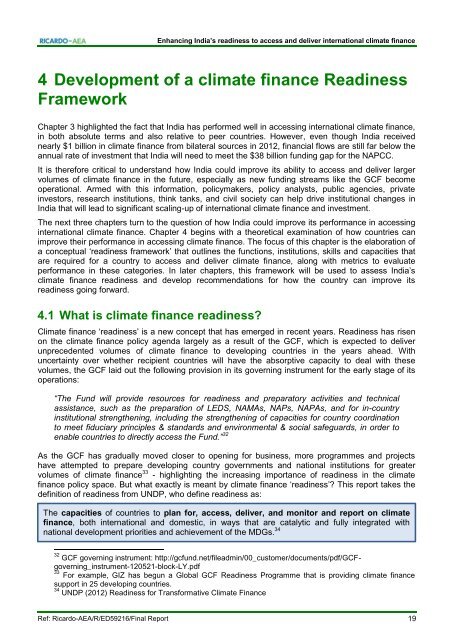Enhancing India’s Readiness to Climate Finance
India has taken several steps to improve its national response to climate change. India’s climate finance requirements, however, are very high, and will need to be met through a combination of public, private and international climate finance. See more at: http://shaktifoundation.in/
India has taken several steps to improve its national response to climate change. India’s climate finance requirements, however, are very high, and will need to be met through a combination of public, private and international climate finance. See more at: http://shaktifoundation.in/
- No tags were found...
You also want an ePaper? Increase the reach of your titles
YUMPU automatically turns print PDFs into web optimized ePapers that Google loves.
<strong>Enhancing</strong> <strong>India’s</strong> readiness <strong>to</strong> access and deliver international climate finance<br />
4 Development of a climate finance <strong>Readiness</strong><br />
Framework<br />
Chapter 3 highlighted the fact that India has performed well in accessing international climate finance,<br />
in both absolute terms and also relative <strong>to</strong> peer countries. However, even though India received<br />
nearly $1 billion in climate finance from bilateral sources in 2012, financial flows are still far below the<br />
annual rate of investment that India will need <strong>to</strong> meet the $38 billion funding gap for the NAPCC.<br />
It is therefore critical <strong>to</strong> understand how India could improve its ability <strong>to</strong> access and deliver larger<br />
volumes of climate finance in the future, especially as new funding streams like the GCF become<br />
operational. Armed with this information, policymakers, policy analysts, public agencies, private<br />
inves<strong>to</strong>rs, research institutions, think tanks, and civil society can help drive institutional changes in<br />
India that will lead <strong>to</strong> significant scaling-up of international climate finance and investment.<br />
The next three chapters turn <strong>to</strong> the question of how India could improve its performance in accessing<br />
international climate finance. Chapter 4 begins with a theoretical examination of how countries can<br />
improve their performance in accessing climate finance. The focus of this chapter is the elaboration of<br />
a conceptual ‘readiness framework’ that outlines the functions, institutions, skills and capacities that<br />
are required for a country <strong>to</strong> access and deliver climate finance, along with metrics <strong>to</strong> evaluate<br />
performance in these categories. In later chapters, this framework will be used <strong>to</strong> assess <strong>India’s</strong><br />
climate finance readiness and develop recommendations for how the country can improve its<br />
readiness going forward.<br />
4.1 What is climate finance readiness?<br />
<strong>Climate</strong> finance ‘readiness’ is a new concept that has emerged in recent years. <strong>Readiness</strong> has risen<br />
on the climate finance policy agenda largely as a result of the GCF, which is expected <strong>to</strong> deliver<br />
unprecedented volumes of climate finance <strong>to</strong> developing countries in the years ahead. With<br />
uncertainty over whether recipient countries will have the absorptive capacity <strong>to</strong> deal with these<br />
volumes, the GCF laid out the following provision in its governing instrument for the early stage of its<br />
operations:<br />
“The Fund will provide resources for readiness and prepara<strong>to</strong>ry activities and technical<br />
assistance, such as the preparation of LEDS, NAMAs, NAPs, NAPAs, and for in-country<br />
institutional strengthening, including the strengthening of capacities for country coordination<br />
<strong>to</strong> meet fiduciary principles & standards and environmental & social safeguards, in order <strong>to</strong><br />
enable countries <strong>to</strong> directly access the Fund.” 32<br />
As the GCF has gradually moved closer <strong>to</strong> opening for business, more programmes and projects<br />
have attempted <strong>to</strong> prepare developing country governments and national institutions for greater<br />
volumes of climate finance 33 - highlighting the increasing importance of readiness in the climate<br />
finance policy space. But what exactly is meant by climate finance ‘readiness’? This report takes the<br />
definition of readiness from UNDP, who define readiness as:<br />
The capacities of countries <strong>to</strong> plan for, access, deliver, and moni<strong>to</strong>r and report on climate<br />
finance, both international and domestic, in ways that are catalytic and fully integrated with<br />
national development priorities and achievement of the MDGs. 34<br />
32 GCF governing instrument: http://gcfund.net/fileadmin/00_cus<strong>to</strong>mer/documents/pdf/GCFgoverning_instrument-120521-block-LY.pdf<br />
33 For example, GIZ has begun a Global GCF <strong>Readiness</strong> Programme that is providing climate finance<br />
support in 25 developing countries.<br />
34 UNDP (2012) <strong>Readiness</strong> for Transformative <strong>Climate</strong> <strong>Finance</strong><br />
Ref: Ricardo-AEA/R/ED59216/Final Report<br />
19

















